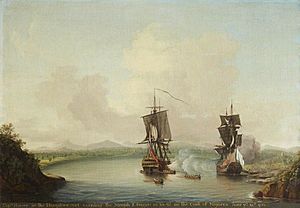HMS Hampton Court (1709) facts for kids

Hampton Court destroying the French frigate La Nymphe in 1757 in the Mediterranean.
|
|
Quick facts for kids History |
|
|---|---|
| Name | HMS Hampton Court |
| Builder | Taylor, Rotherhithe |
| Launched | 19 August 1709 |
| Fate | Broken up, 1774 |
| General characteristics as built | |
| Class and type | 1706 Establishment 70-gun third-rate ship of the line |
| Tons burthen | 1,137 bm |
| Length | 150 ft (45.7 m) (gundeck) |
| Beam | 41 ft (12.5 m) |
| Depth of hold | 17 ft 4 in (5.3 m) |
| Propulsion | Sails |
| Sail plan | Full-rigged ship |
| Armament |
|
| General characteristics after 1744 rebuild | |
| Class and type | 1741 proposals 64-gun third rate ship of the line |
| Tons burthen | 1,283 |
| Length | 154 ft (46.9 m) (gundeck) |
| Beam | 44 ft (13.4 m) |
| Depth of hold | 18 ft 11 in (5.8 m) |
| Propulsion | Sails |
| Sail plan | Full-rigged ship |
| Armament |
|
HMS Hampton Court was a powerful warship of the Royal Navy, built in the early 1700s. It was known as a "ship of the line," meaning it was a large, strong ship designed to fight in battle lines. It was first built with 70 guns, making it a "third-rate" ship. The ship was launched on August 19, 1709.
Contents
Early Service and Battles
Joining the Fleet
Hampton Court became part of Vice-Admiral Edward Vernon's fleet. This fleet was very important for Great Britain's navy.
War in the Caribbean
The ship took part in a major event called the Battle of Cartagena de Indias. This battle happened during the War of Jenkins' Ear. This war was a conflict between Great Britain and Spain. The battle took place in the Caribbean Sea.
Rebuilding the Ship
A Major Upgrade
In December 1741, orders were given to rebuild Hampton Court. The ship was taken apart at Deptford Dockyard. It was then rebuilt as a slightly different kind of warship.
New Design and Guns
After its rebuild, Hampton Court became a 64-gun third-rate ship. It was relaunched on April 3, 1744. The rebuild made the ship stronger and updated its design.
An Unexpected Encounter
Mistaken Identity at Sea
In November 1745, Hampton Court had a strange encounter. It met another British Royal Navy ship, HMS Defiance. Both ships thought the other was a French warship.
Friendly Fire Incident
They started firing at each other from a distance. After about half an hour, the crew of Defiance saw British markings on the cannonballs hitting their ship. They quickly signaled for a truce, stopping the fight.
End of Service
Hampton Court continued to serve the Royal Navy for many years. It remained active until 1774. At that time, the ship was "broken up," which means it was taken apart. This was a common way to retire old warships.
Images for kids
-
Shown here as a member Sir George Pocock's Blue Squadron, around 1762.


